Eight Lives of El Condor
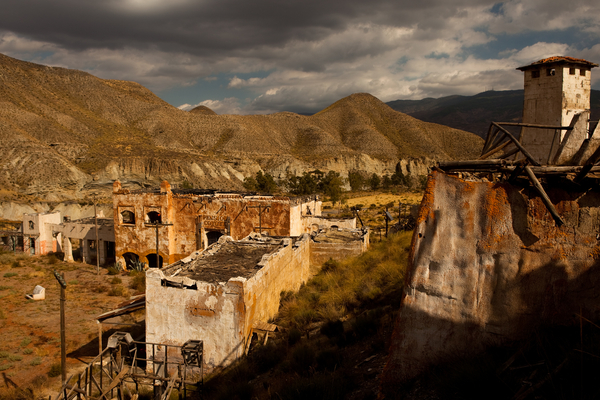
The camera is usually shooting out from the hillside, looking down over the installation. The sun sets behind the hillside, so the few glimpses in that direction are somewhat obscured by the glare of sunlight.
One of the most intriguing locations in Almeria is the site of an elaborate fortress originally constructed in 1969 for the film El Condor. Adobe houses, horse stables, an elevated water tank, and a luxurious two story stone house surrounded a central plaza the size of a soccer field. The entire complex was circled by 30 foot walls with a network of watchtowers and stairways. The fort is situated against a steep hillside, with the towers above offering a sweeping view over the surrounding landscape.
El Condor (1969)
Football star Jim Brown, as the escaped convict, teams up with Lee Van Cleef, alcoholic gunslinger, to pursue a fortune in gold secured inside the Mexican fortress known as ‘El Condor’. The fortress is guarded by the powerful General Chavez and his troops. With the aid of Van Cleef’s Apache allies, the duo manage to invade the fort twice, each time aided by female distractions and accompanied by generous gunfire and explosives. First, they get past the walls posing as members of Chavez’ army. They wear the uniforms of Chavez’ soldiers after attacking a group of them in a nearby town while they lay naked in bed with the local women. The second time, the team quietly climbs the outer walls while the patrolling guards are transfixed by Marianna Hill, the General’s mistress, strategically undressing in front of a second floor window.
But it was the enormous set itself, and its explosive destruction, that became the star of the show. Created by production designer Julio Molina, the fortress took two months to construct. Screenwriter Larry Cohen was reportedly asked to rewrite the script to focus more of the action around the fortress. Indeed, much of the second half of the film consists of Brown and Van Cleef battling their way in and out of the complex. Producer Andre de Toth was on familiar terms with the landscape of Almeria, having previously served as a second unit director for Lawrence of Arabia and directed Play Dirty with Michael Cain. During filming, Carlos Robles Piquer, Spain’s Minister of Culture at the time, visited the El Condor set and other film locations in Almeria, seeking to further develop movie-making and tourism in the region.
The movie was not well received by critics at the time. Roger Ebert lamented the loss of the virtuous hero; “The new violent Westerns are nihilistic in their disregard for any kind of traditional value system.” New York Times critic Roger Greenspun decried the heavy reliance on explosions and female nudity driving towards its ‘sexual-military climax.’ “When you create a vacuum,” he wrote, “in art as in nature, something ambles in to fill the empty spaces, and in the void that is ‘El Condor’ that something is a death that chills desire.”
One of dozens of westerns filmed in Almeria, El Condor was made during the height of the movie boom here. But within a few years people were already talking about the demise of the genre, and the film industry in Almeria was struggling. Little remains of the expansive set today. Most of the fortress wall is now gone, but some of the buildings remain, including the palace, along with pieces of the wall reaching up the hillside.
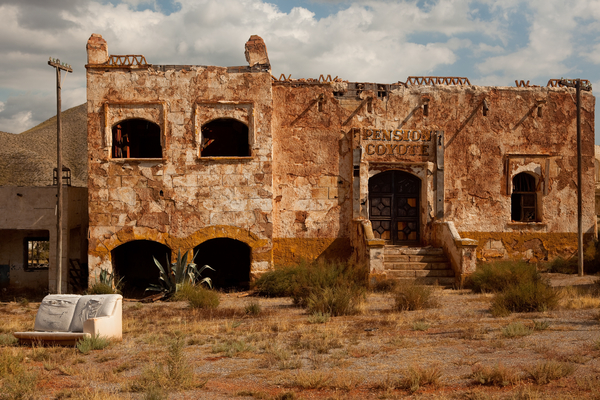
This building was the General’s luxurious house, from where Marianna Hill’s striptease distracts the guards. It features in subsequent films as well. The ‘Pension Coyote’ sign was added for the film Honolulu Baby.
Blindman (1971)
Ringo Starr plays a lovestruck Mexican thief who falls for a woman held hostage by his more sinister older brother. The film makes use of several familiar locations around Almeria, but the main action takes place at the brothers’ hideout (the El Condor fort, of course). Inside, fifty women are forced to perform burlesque in a tavern theater (the Pension Coyote house). After generous gunfire and explosions throughout the fortress, the women are finally freed by a blind gunslinger (Tony Anthony) and seen running out of the building covered in white sheets, looking like defectors escaping a strange cult.
A Reason to Live a Reason to Die (1972)
James Coburn plays Colonel Pembroke, a Union Civil War officer who is viewed as a traitor for surrendering Fort Holman (El Condor, again) to the Confederates without a shot being fired. He proposes to lead a mission to retake the fort, freeing seven condemned criminals from hanging in exchange for their assistance. In addition to half a million dollars in gold inside the fort to hold the group’s interest, Pembroke is driven by a personal vendetta against Major Ward, the Confederate commander who now rules from the fort headquarters (Pension Coyote), and is ready to risk everything on the mission. The fort is said to be “impregnable to a frontal attack, impossible to infiltrate.” But Pembroke, who knows the site inside and out, has a dangerous plan to enter from behind, hoisting themselves up the cliff, sneaking across a hanging bridge, and blasting through a hillside tunnel with dynamite. Once inside, the entire complex erupts in gunfire as Pembroke and his pals turn the fort’s heavy artillery against its defenders. The fight kills off almost all the participants on both sides. Pembroke finally comes face to face with Major Ward. In the end, he regains the fort and gets his vengeance. A trailer for the film can be seen here.
Get Mean (1975)
An American woman claims to be a Spanish princess and rightful heir. Tony Anthony, as The Stranger, grudgingly agrees to escort her to Spain to claim her kingdom. As soon as they arrive, they get caught up in a battle between Moors and Vikings, both in full armor (never mind historical accuracy). The princess is taken hostage by the evil barbarian leader Diego and held at his compound (El Condor). As a mysterious nighttime procession of hundreds of red-cloaked followers arrives at the fortress, the Stranger finally gets fed up and begins throwing dynamite around the fortress, eventually defeating the barbarians, freeing the princess, and recovering a hidden fortune. Luis Lorenzo has an uncredited appearance as a comical effeminate sidekick to the barbarian leader, a role he repeats at the same location several years later in Hundra. The website getsmean.com has information about the Stranger series and Tony Anthony, including behind the scenes footage.
Conan the Barbarian (1982)
Conan the Barbarian was filmed entirely in Spain, on location and in Madrid studios. Director John Milius insisted on creating an entirely original world without relying on existing architecture and design elements. Designer Ron Cobb told Cinefantastique “I was dead set against using available old parts of towns and dressing them up to look like an ancient world.” He began to design a series of original buildings, but constructing an entire city was simply too expensive. So, in the end, they did incorporate some existing architecture, but transformed them, increasing their scale and complexity, with creative use of foreground miniature models. The El Condor fort appears only briefly as the first island of civilization that Conan and Subotai pass through on their journey to Zamora. They stand in awe at the immense walls stretching up the hillside. Through the use of miniatures created by Emilio Ruiz, the fort appears even larger and more densely developed. Once inside the walls, as the duo stroll through the chaotic center eating barbequed lizard on a stick, the Pension Coyote house can be seen in the background.
Hundra (1983)
Hundra is a kind of female Conan. Raised as an Amazon warrior, she inherits the responsibility of repopulating the all-women tribe after the others are slaughtered by barbarians. She makes her way to a walled city (El Condor) to find a man. However, she soon finds herself being chased up and down the city walls by clumsy male guards who are no match for her fighting skills. The town is dominated by a self-appointed priest who kidnaps young women to bring them to his “Temple” and turn them out as submissive playthings for the male chieftans. The Pension Coyote building serves as the pimp’s palace and entryway to the Temple. Hundra eventually frees herself, finds love, destroys the evil priest and brings peace to the walled city. Cinematographer John Cabrera had previously worked on Conan the Barbarian and the production crew reused some of the leftover sets and costumes.
Dollar for the Dead (1998)
This TNT film, marketed as a tribute to Sergio Leone, used many of the original western locations in Almeria. Emilio Estevez is a nameless gunslinger on the run who teams up with a former Confederate soldier (William Forsythe) with clues to a hidden fortune in gold. As they piece together the treasure map they attract other pursuers, Spanish and Union soldiers, along with the wealthy rancher already after Estevez for killing his son. The gold is hidden in an impenetrable Mexican fortress (El Condor, you might guess). The finale involves a hail of gunfire with Forsyth stationed on the hillside above the fort behind a machine gun (hidden inside a coffin dragged around throughout the film, a reference to the original Django) and Estevez storming the main entry while throwing sticks of dynamite. Estevez ends the final standoff by charging out of the Pension Coyote building, completing a somersault in mid-air, and landing on his feet to simultaneously shoot the two remaining soldiers who had been waiting for him outside. Tony Anthony (The Stranger and the Blindman) was a coproducer.
Honolulu Baby (2000)
Working a dead end desk job at a faceless multinational corporation, Alberto Colombo (Maurizio Nichetti) is sent on assignment to Latin America to search for oil. Previous employees sent to the outpost have disappeared and Colombo fears the worst. However, he discovers that the remote town is populated entirely by beautiful women and his “missing” colleagues are in no hurry to leave. But he ultimately learns that paradise can have its downsides too. The picture was shot on 35 mm film and then transferred to digital video for post-production, a first for Italian film at the time. (Variety Magazine Reviews Honolulu Baby) Much of the original fortress wall was gone by this time, leaving behind a cluster of small buildings which make up the town. The painted signs that still appear–‘Pension Coyote’, ‘Bar’–are leftovers from the making of Honolulu Baby. Photographs, video and reports from the production are availabe on Nichetti’s website at www.nichetti.it.
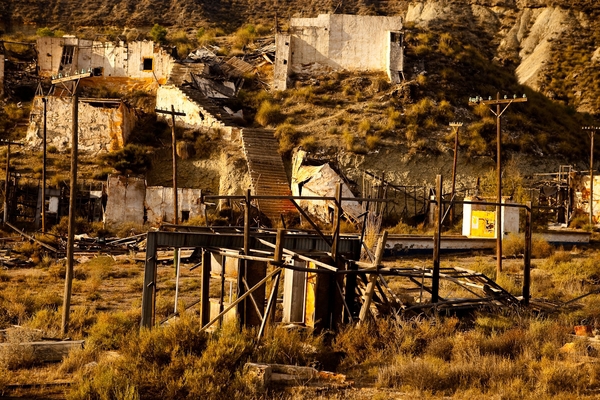
Today little remains of the original set. Unlike other nearby western sets which have reopened for tourists, El Condor is isolated, accessible only by hiking from a nearby access road, and on private land. The owners, who have largely left the site to decay, do not take kindly to visiting photographers and film historians. But it remains an incredible setting, a strange kind of ghost town, one with multiple histories, surrounded on all sides by dramatic desert mountains.
One November morning I arrived early to photograph the site at sunrise. The landscape was entirely silent except for the wind. After working there alone for a couple of hours a jeep suddenly sped up containing an older man in a blue work uniform and a young boy holding a rifle. “What are you doing here?” the man demanded angrily. “Taking pictures,” I responded. He launched into a tirade about how I was on private property and not supposed to be there for any reason. The he pointed to the rifle and said “Podemos darte un tiro!” (“We could shoot you!”). I calmly packed up my gear while they watched and then hiked back over the hillside, past the “No Entry” sign, to where I’d left my rental car. At least I felt like I’d regained some of the adventure hidden in these ruins from lives past.
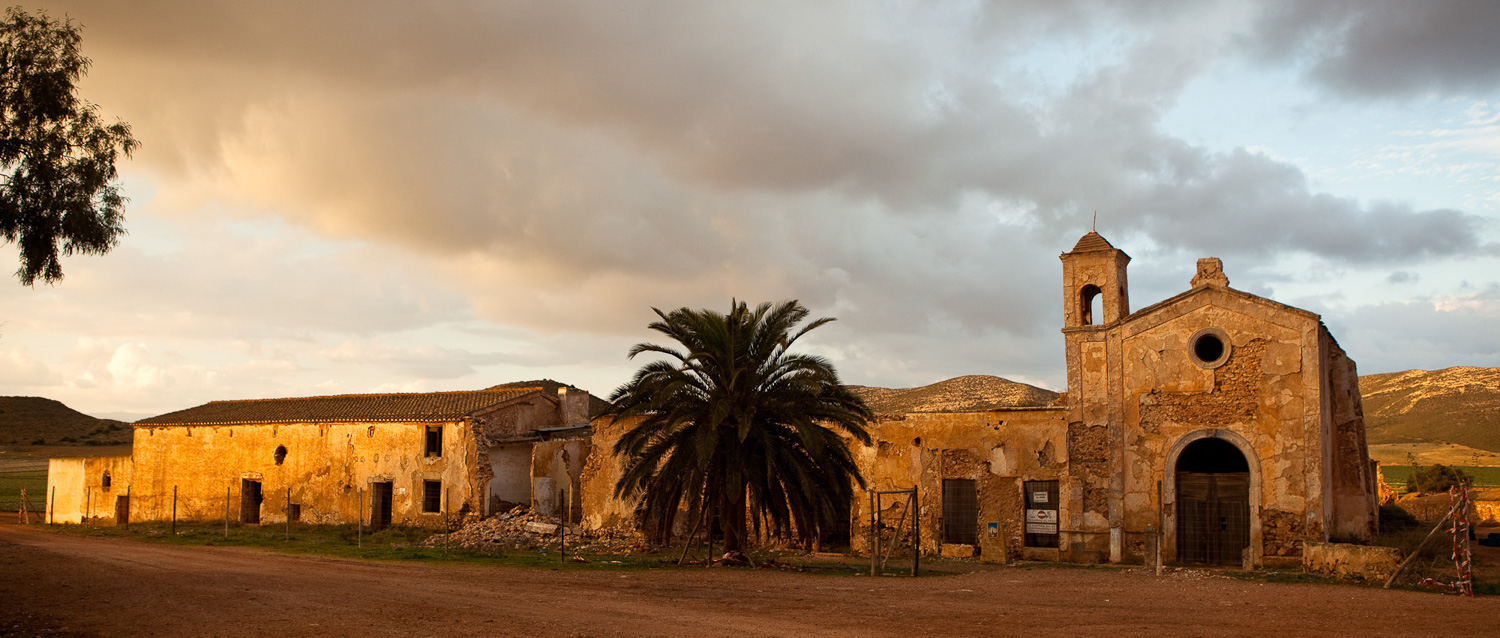

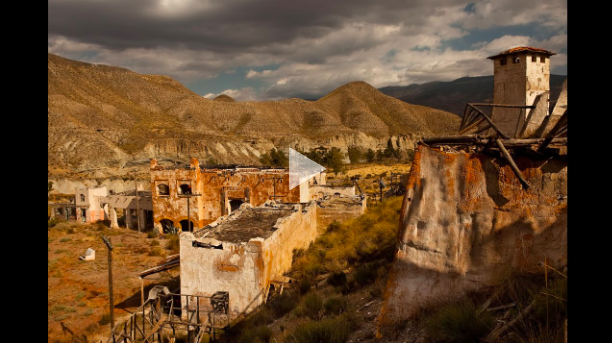
Hi,
Great Photos and I’ve been meaning to visit this spot for several years but you have pretty much put me off with your talk of angry farmers.
Thanks for Sharing